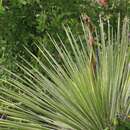Comments
provided by eFloras
Yucca arkansana shows considerable variation, particularly in the eastern part of its range. S. D. McKelvey (1938–1947) described var. paniculata and suggested that it is an eastern extension of the species with a taller, paniculate, and pubescent inflorescence. Yucca arkansana approaches Y. louisianensis, which we have reduced to synonymy under Y. flaccida. K. H. Clary’s (1997) DNA consensus tree places Y. arkansana and Y. louisianensis adjacent to one another.
- license
- cc-by-nc-sa-3.0
- copyright
- Missouri Botanical Garden, 4344 Shaw Boulevard, St. Louis, MO, 63110 USA
Description
provided by eFloras
Plants forming small colonies, acaulescent or caulescent; rosettes usually small. Stems decumbent, short, to 0.2 m. Leaf blade mostly yellowish green, flattened, grasslike, concavo-convex, widest near middle, 20–60(–70) × 0.7–2(–2.5) cm, flexible, margins entire, curled, filiferous, apex long, tapering to short spines 1.6–3.2 mm. Inflorescences racemose, occasionally paniculate proximally, arising within rosettes or at rosette level, 3–6(–8) dm, glabrous; bracts erect; peduncle scapelike, 0.2–0.5(–0.6) m, 0.3–0.7(–1.3) cm diam. Flowers pendent; perianth globose; tepals distinct, greenish white, elliptic to orbicular or oblong, 3.2–6.5 × 2–5 cm; filaments 1.3–2.5 cm; anthers 3.2 mm; pistil 2.5–2.8(–3.2) cm; style dark green, 7–13 mm, tumid; stigmas lobed. Fruits erect, capsular, dehiscent, oblong-cylindric to obovoid, constricted near middle, stout, 4–6.5(–7) × 2–3 cm, dehiscence septicidal. Seeds dull black, thin, ca. 1 cm diam.
- license
- cc-by-nc-sa-3.0
- copyright
- Missouri Botanical Garden, 4344 Shaw Boulevard, St. Louis, MO, 63110 USA
Distribution
provided by eFloras
Ark., Kans., Mo., Okla., Tex.
- license
- cc-by-nc-sa-3.0
- copyright
- Missouri Botanical Garden, 4344 Shaw Boulevard, St. Louis, MO, 63110 USA
Habitat
provided by eFloras
Gravelly soil, limestone outcrops, rocky hillsides, prairies; 100--400m.
- license
- cc-by-nc-sa-3.0
- copyright
- Missouri Botanical Garden, 4344 Shaw Boulevard, St. Louis, MO, 63110 USA
Synonym
provided by eFloras
Yucca angustifolia Pursh var. mollis Engelmann; Y. arkansana var. paniculata McKelvey; Y. glauca Nuttall var. mollis Engelmann ex Branner & Coville
- license
- cc-by-nc-sa-3.0
- copyright
- Missouri Botanical Garden, 4344 Shaw Boulevard, St. Louis, MO, 63110 USA
Yucca arkansana: Brief Summary
provided by wikipedia EN
Yucca arkansana, the Arkansas yucca, is a plant in the family Asparagaceae, native to Texas, Oklahoma, Arkansas, Missouri and Kansas. It generally grows in gravelly, sunlit locations such as rocky outcrops, prairies, etc. It is not considered to be threatened.
Yucca arkansana is one of the smaller members of the genus Yucca, acaulescent or with a stem no more than 76 cm tall. Flowers are greenish-white, borne on a flowering stalk up to 180 cm (72 inches) tall.
A number of yucca moths lay their eggs upon Y. arkansana as a host plant, an example being Tegeticula intermedia.
- license
- cc-by-sa-3.0
- copyright
- Wikipedia authors and editors

